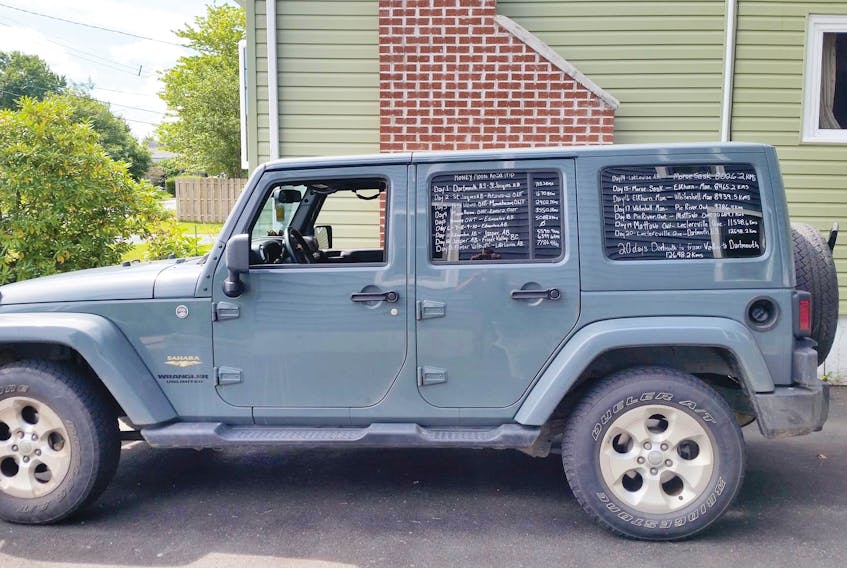Two days after their wedding, Emily Tapper and Sidney Coakley packed their gear into their Jeep and set off on a three-week adventure that saw them camp — often for free — throughout Canada.
“We probably spent between $200 and $250 in accommodations for the month. If we’d had to stay in hotels, we wouldn’t have been able to afford it,” said Tapper.
“By doing it this way, we were able to stretch our budget,” she said.
The 30-somethings made a platform in the back of their four-door Wrangler with spare two-by-fours and a bit of extra plywood left over in the basement of their house in Dartmouth, N.S. They brought a tent, cooler, and camping gear, including a Coleman propane stove.
Then, equipped with a lot of research on free or very cheap campsites, they pointed their grey Jeep west and drove away.

Their first stop? An abandoned quarry outside of Edmundston, N.B., just before that province’s border with Quebec.
“It was on a hillside. It had a beautiful view,” said Tapper. “It had no amenities but there was a Tim Hortons nearby.”
Alone on that beautiful hillside, the couple made a campfire, had a few drinks, and relaxed.
At national parks like the ever-popular and well-maintained Prince Edward Island National Park, the daily entrance fee for a family during the peak season is $15.70. A campsite with all the services in the park’s Cavendish location is another $35.30 per day.
That’s a total cost just to gain access to the campsite of $51 per day, or $357 per week. That cost might make parents on a tight budget balk at the idea of a week of camping with their children.
But there are ways to cut those costs.
When Tapper and Coakley camped on the hillside in northwestern New Brunswick, they did so for free. There were no campground entrance fees. And no campsite fees either.
It also wasn’t just in New Brunswick that the couple snagged a free campsite. The two also stayed for free in an overflow campsite, a large grassy area with handwashing stations and pit toilets, at Lake Louise in the spectacular Banff National Park in Alberta.
During their cross-Canada honeymoon, Tapper and Coakley enjoyed a few amenities and didn’t exactly rough it all the way. They showered in visitor information centres and truck stop showers, stayed with friends a couple of times, and even splurged for a hotel room one night.
Standing six-foot-three, Coakley says the toughest part of the trip for him was simply being cramped in the car for drives of up to 15 hours at a time.
But at least that came with bragging rights.
“The best part for me was being able to drive across the country, just to say I did it,” he said.
Evenings for him and Tapper consisted of kicking back and enjoying a bonfire and beers.
“I made sure that I was able to get my Alexander Keith’s wherever I went,” said Coakley. “When we were travelling, we got to listen to the last Tragically Hip concert around the bonfire with a beer and a steak.”
A great deal, but campers should know what’s in store
Throughout Canada, a lot of wilderness is just begging to be explored — and often completely free for campers.
There are websites to get the skinny on these free campsites. One such online resource is FreeCampsites.net which allows users to look up only those places which are free to camp. That information is provided by users. The website itself admits the content has not been verified.
Another way to find out about free campsites is the WikiCamps Canada app. It's billed itself as “the largest and most up-to-date database of campgrounds, RV parks, backpacker hostels, day use areas, points of interest, information centres and public dump points.”
Kept up-to-date by users, the WikiCamps app downloads the information onto the user’s device, making it available even when there’s no cellphone connection or Wi-Fi.
On their cross-country trek, Emily Tapper and Sidney Coakley used the Backroads Mapbooks series. Its books are filled with maps for each province of Canada along with information about hiking trails, fishing and hunting spots, and Crown lands and parks.
For those who want to access the information on their phone or tablet, Backroads Mapbooks also has its Navigator app, available through the Google and iTunes apps stores.
Camping on Crown land, though, isn’t for everyone.
“You have to do your homework, know what resources you need,” said Tapper. “Not everyone is OK peeing in the woods.”
But the trade-off for missing out on amenities like showers and flush toilets and electrical outlets on Crown land designated as wilderness areas is that they offer great scenery and much more affordable camping.
Peter Labor, Nova Scotia’s director of protected areas and ecosystems, says the more than 80 wilderness areas in that province exist primarily to save protected species and preserve biodiversity but that they are also open to recreational users.
“It’s free, just as on other Crown lands where people are free to travel in a low-impact way,” he said.
On its website, at www.novascotia.ca/nse/protectedareas/map.asp, the Province of Nova Scotia keeps a full list of all its wilderness areas with information about them.
Newfoundland and Labrador does something similar, at www.flr.gov.nl.ca/natural_areas/pdf/reserves_web.pdf; that province lets people know which of its wilderness and ecological reserves allow wilderness camping.
With few exceptions — those areas where specially-permitted ATV or mountain bike trails exist — any mode of transportation with wheels is prohibited on these Crown lands.
Think canoeing, kayaking and hiking instead.

All camping there is to be done in tents — or without a shelter of any kind under starry skies — and leave no trace whatsoever that anyone was ever there. Bonfires are not allowed. In some places there are already-established campfire areas. In others, only propane stoves are allowed.
Matt Parker, director of parks for Nova Scotia’s Department of Natural Resources, says camping or having campfires on any publicly-owned beach is also not allowed.
And any litter — or human or animal waste — has to be packed out or buried 15 to 20 cm deep and then covered to hide all traces of the cathole.
It’s a good idea to check with each province’s department responsible for these wilderness areas as the rules can vary from one region to the other. Some do not allow camping in all areas and may require taking out free permits before people can head into those forests.
Campers are also urged by provincial officials to be realistic about their own capabilities and their expectations about the likelihood of finding good places to pitch their tents before heading into wilderness areas. These places can be huge.
The Tobeatic wilderness area in Nova Scotia, for example, spans almost 1,200 square kilometres and includes more than 100 lakes, making it the biggest protected area in the Maritimes. An almost barren landscape surrounded by pockets of old-growth pine and hemlock, this is a beautiful spot for camping but it’s also a massive area.
And yet, even the Tobeatic pales in size compared to Newfoundland's 2,895-square-kilometre Bay du Nord wilderness reserve, the wintering and calving grounds of a herd of 15,000 woodland caribou.
“Some of these areas are beautiful examples of nature and as people experience them they want to share them with others ... but if it takes you two days to canoe to a lake, there are fewer camping areas there,” said Labor.
These are places for only the hardiest of campers.









